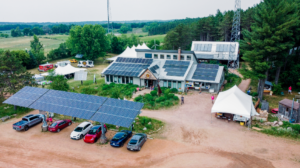The following is a research/opinion article written by an MREA intern after her experience at The Energy Fair.
The Electric Vehicle (EV) Market
It doesn’t take long to see optimism for the EV market. Just taking a minute to check out some of the new EV models that are out on the market today will be sure to impress you. These luxurious vehicles will catch anyone’s eye with some of the amazing features and designs. There are many improvements that are being made in the engineering world to make EVs more attractive to society. There have been breakthroughs such as wireless charging installed in highways to charge the vehicle while driving, and fast chargers that can charge a battery in less than 10 minutes. All of these possibilities and opportunities for the future suggest a changing vehicle industry and market.
There isn’t one answer for what the ultimate EV looks like. Every lifestyle can benefit from the variety of EVs available. The market is currently trending toward more luxury EVs, and because of this, the prices are trending upwards. This means that the EV market has been selling higher quality vehicles, but these higher prices make them less attainable for many people to purchase. While working the EV charging station at The 32nd Annual Energy Fair, I noticed that the Chevy Bolt, a very affordable EV option, was one of the most common vehicles to be plugged in. This simple observation suggests that more affordable EVs would result in even more growth in the already increasing EV popularity. However, Chevy announced that they are discontinuing the Chevy Bolt to focus on making models for EV trucks. This is the latest trend happening in the EV market – the widespread addition of larger EVs such as SUVs, trucks, and even larger vans.

Charging
With larger vehicles becoming more popular in this expanding market, this must raise some questions when thinking about charging these bigger vehicles with bigger batteries. And with EV’s getting more popular, there needs to be more access to charging in rural locations. Right now, it is completely feasible to drive an electric vehicle if you live and work near larger cities where there are plenty of charging opportunities. Also, EVs are most efficient for driving in a city, which makes EVs completely feasible for those who don’t leave an urban area often. However, it’s inevitable that many people must drive on highways, either regularly for work or to take a longer trip. After looking at EV charging infrastructure, there is a lack of readily accessible charging when traveling outside of urban areas. Many EV owners at The Energy Fair said that when they take road trips up to northern Wisconsin, they must take a detour to stop at the MREA to charge since it is one of the last charging locations open for a long stretch.
After speaking with many of the EV charging attendees at the 2023 Energy Fair, some said that level 1 and 2 chargers are almost useless since they can’t charge fast enough to meet their needs. These EV owners only use level 3 fast chargers. This is much different from other EV owners who have never taken their cars out to charge anywhere other than their home. Here, it’s most common to use level 1 and 2 chargers at home. This proves that every lifestyle and EV owner has a different situation and preference when it comes to charging their vehicles.
Ultimately, EVs cannot be judged as good or bad, because every lifestyle has different wants and needs for their ideal vehicle. Taking a minute to look at some of the new EV models may inspire you to think twice about the next vehicle you purchase and whether you may want to transition to EV. There is work to be done in the industry, but a very promising future ahead.


